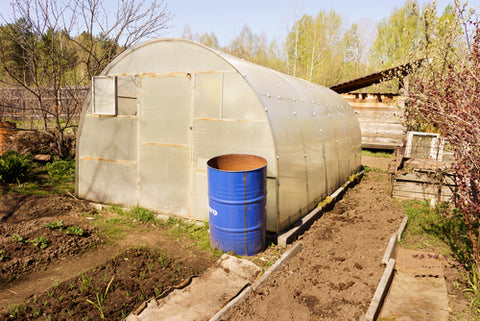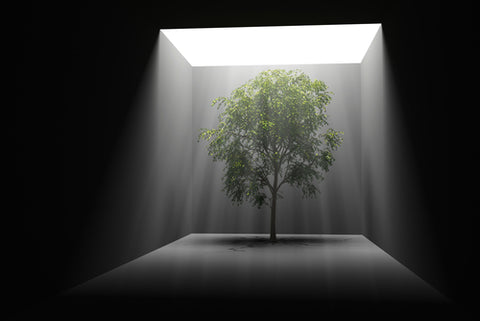There is nothing quite like enjoying your own freshly grown produce and herbs. Unfortunately, many of us don’t live in a climate that lets us grow the plants we want outside year-round. Thankfully, there are ways around that; one of these is by setting up your own greenhouse. If you don’t have the land available to use to build a greenhouse, you can still take advantage of home grown vegetables and herbs. You just need to build yourself a grow room.
The great thing about a grow room is that you can adjust it to suit your growing needs. Whether it’s just a couple of tomato plants, or you’re looking to grow an entire garden, you can upsize or downsize your growing operation. The only constraint you have is the size of the room you plan on converting into a grow room and your budget.
When you design your grow room, you want to look at three things. First, ventilation is key to healthy plants. Second, you need to decide how many plants you’re going to grow. And lastly, you need to set up the proper lights to help your plants grow. Once you set up your lights, you can work on climate control as well.
Let the Air In and Out!

If your grow room isn’t ventilated properly, you’re going to run into two major issues. One, the room will be too hot from the grow lights. Two, the air will become too humid, which will be bad for your fruits and veggies and will also promote the growth of mold and mildew on or even in the walls.
The key is getting air in and getting the air out. People have found success in running duct work either through the floor and out of the basement or crawl space, or going up to the attic and drawing air from there. Whichever you choose, you need to make sure you are using the correct fans.
Fans are measured in their cubic foot per minute rating. In general, you want the air in your grow room to circulate at least 8 to 9 total air changes per hour. That means if your grow room is in a spare bedroom that measures 8’ x 8’ by 7’, that’s 448 cubic feet. for 8 air changes per hour, that’s 3584 cubic feet per hour. To find the cfm, divide that by 60, so you need a circulation system that will handle 60 cfm. This can be one inline fan in your ducts, or you can run fans in parallel to move more air.
This is also where you consider active charcoal filtering. If you’re growing plants with a strong odor, such as garlic, mushrooms, or stronger herbs, inline charcoal filters will ensure that your entire house doesn’t smell like compost from your mushroom beds.
What Are You Growing?

After you calculate how much ventilation you will need for your new grow room, you should look at how you’re going to store your new crop. One of the coolest new things to enter the home garden arena is the grow bag. These soft sided bags come in multiple sizes and can be moved around to rotate crops. Some bags are large enough to handle multiple plants at a time, making much more efficient use of your space than traditional pots.
Grow bags also make it easy come harvest time as you can shift and move the bags where you need them in order to get the fruits of your labor.
Once you determine the size of your crop, you can estimate how much soil you will need and plot out the growing areas.
Let the Sun Shine In

The next crucial thing your plants will need is light. Ordinary incandescent bulbs won’t do either. You need bulbs that mimic the full spectrum of sunlight or your plants are going to suffer. Your grow lamps should be ceiling mounted for the best results. When you ceiling mount them, make sure to keep a space between the light and the ceiling for air flow. Grow lights get hot, so you want to allow them to cool as much as possible. Depending on the wattage of the bulbs, you’ll need to adjust how low your lights hang.
As a general rule of thumb, if your bulb is only 150 watts, you can keep it as close as 8-inches from your plant. More powerful lights, such as 1000 watt bulbs require at least 2-1/2 feet between the bulb and your plant.
Because grow lamps pull a lot of power, you may find it best to install a new circuit breaker in your home’s electrical panel so you don’t stress out another circuit. Additionally, use a timer to control when your sun comes up and when it goes down. While you might think that 24-hour days would be great for your tomato plants, they actually need darkness to recuperate and do plant things.
If you’re concerned about light efficiency, reflective bubble insulation on the walls will help keep the lights focused on where they should be. With the reflective paper, the light isn’t being absorbed by the walls of your grow room, it’s reflected back onto your happy plants.
Climate control can be handled by adding either a humidifier or a dehumidifier, depending on your climate. If you live in the deep south, you may need a dehumidifier to reach the optimal moisture content for your green peppers. Likewise, if you live in Colorado, you’ll need a humidifier to add moisture to the cold and dry mountain air.
You don’t want your plant’s leaves to get wet, because that’s a recipe for a fungal outbreak such as powdery mildew or Botrytis. For a tomato plant, the ideal indoor humidity is 80 to 90 percent during the day and 65 to 75 percent at night. That allows proper transpiration and nutrient transport through the plant. Keep the humidity too high, and the plant will suffocate because transpiration won’t be able to pull water and nutrients up from the roots. Make sure to check with your local master gardeners to find out the ideal humidity levels for your crop.
Monitor your temperature levels as well. Making sure your plants don’t get too cold will ensure the maximum yield come harvest time. Once you get used to how your plants prefer their environment, keeping it that way will become second nature.
Grow rooms and indoor greenhouses are a great way for you to supplement your diet. Having access to fresh fruits and vegetables will increase the health and well-being of both you and your family. With just a little work, you can convert any unused space in your home into a well-organized and efficient grow room that will provide fresh produce for years to come.


